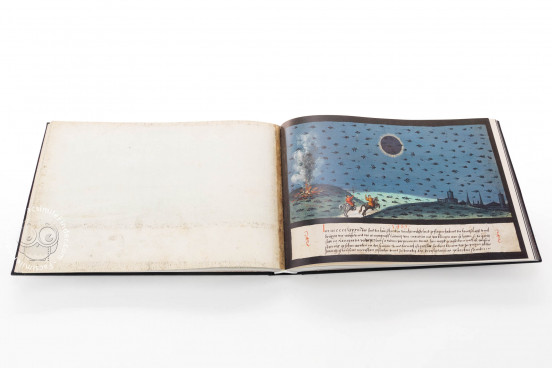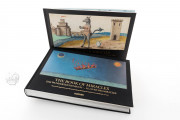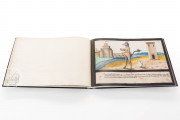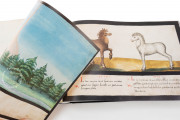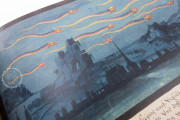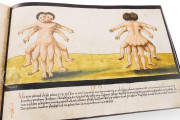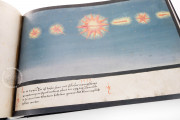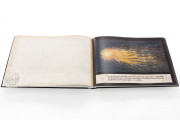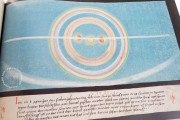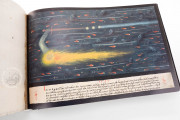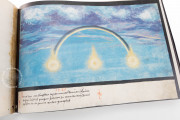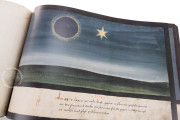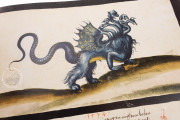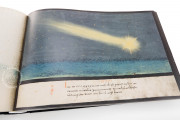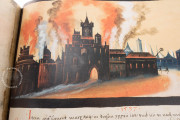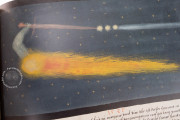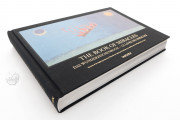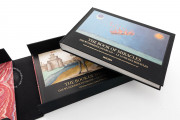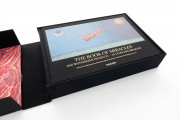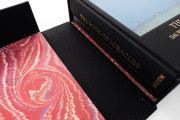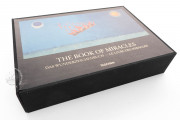The Book of Miracles is an album of gouache paintings depicting wondrous signs from the biblical Flood to the End Times, each accompanied by a caption. It was created in Augsburg and completed soon after 1552. Hans Burgkmair the Younger and Heinrich Vogtherr the Younger, working with assistants, created the manuscript's images of episodes recorded in the Christian Old Testament, as well as historical events, concluding with scenes from Saint John the Divine's vision of the end of time. Its 169 surviving paintings and captions occupy the rectos of the manuscript's leaves.
The textual sources for the book's pictured events are varied, the most prevalent being the Bible and Sebastian Franck's Chronica, Zeitbuch und Geschichtsbibel (Chronicle, Time Book, and Historical Bible), a wide-ranging history of Christianity first published in 1531. The ancient Jewish historian Flavius Josephus (1st century CE) is credited in the captions for two of the book's images.
Marvels and Wonders
The book's paintings feature miracles, often involving blood or food; celestial apparitions (figured clouds, eclipses, comets, etc.); natural disasters (earthquakes, a volcanic eruption, floods, and hailstorms); unusual beings (such as two-headed beasts), and scenes from the Apocalypse.
Of particular interest and high artistic quality are two representations of three "mock suns"—caused by light refractions through ice crystals—appearing over Vienna on January 7, 1520 (fols. 102r and 106r). The latest depicted event is a hailstorm that occurred in Dordrecht in 1552 (fol. 171r).
A Man Who Bought a Skin
The German-language caption for a painting of two calves, one stillborn and two-headed, reads "I, Hans Burgkmair, painter, bought the skin for half a guilder from a parchment-maker" (fol. 117r). Although he doesn't claim to be the author of the painting, Burgkmair is believed to have contributed many of the manuscript's paintings.
Models in Print
Many of the manuscript's Old Testament scenes are based on but are not direct copies of woodcuts by Hans Holbein the Younger and Sebald Beham, and Beham's woodcut cycle of Apocalypse illustrations inspired the images of Saint John's vision. The image of the so-called monstrous pig of Landser (fol. 88r) is adapted from a famous engraving of the subject by Albrecht Dürer. In each case, the composition of the model was adapted to the unusually wide format of the manuscript's pages.
Monumental Presentation
Each recto of the album is mostly occupied by a painting, with a caption underneath. Each image and caption pair is framed by a black border. The text—mostly, but not entirely, the work of a single scribe—is written either in long lines or in two columns in a practiced semi-formal script.
A Confusing Caption
Most of the captions provide historical details about the depicted events, often clarifying the circumstances of a celestial apparition that might otherwise be obscure to the viewer. One caption, by contrast, is perplexing: the eruption of Vesuvius that occurred in 79 CE is dated to 1482, but the caption also reports that the ancient Roman historian and naturalist Pliny the Elder was a victim of the disaster (which he was).
Survival and Losses
The manuscript in the private collection of Mickey Cartin comprises 167 leaves with paintings plus twenty-three blank leaves inserted when leaves bearing paintings were estranged from the book in a nineteenth-century rebinding. Four more leaves with paintings are known to have survived into the twenty-first century, one in a collection in Stuttgart.
We have 1 facsimile edition of the manuscript "Book of Miracles": The Book of Miracles facsimile edition, published by Taschen, 2013
Request Info / Price
